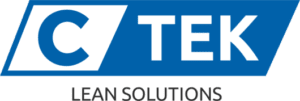The 5 dimensions of lean implementation explained
Lean implementation is comprised of five main dimensions, which are transactional, organizational, spatial, time, and resources. Collectively, these dimensions help companies function more effectively and efficiently throughout the production process. Ultimately, their goal is to maximize profit and efficiency while reducing waste. The experts at C Tek Lean Solutions will walk you through the steps of lean implementation to show how they add up to more efficient production.
Spatial
The first dimension of lean manufacturing is spatial. Spatial dimension refers to the use of space in lean production. It addresses issues that may interfere with production and don’t make the best use of available space. By looking at the issues that lead to lack of space or improper use of space, companies can better understand how to make positive changes. That may include removing obstructions such as walls and rails, making aisles easier to navigate, and redesigning storage areas to get clutter off the floor and out of the way.
Transactional
This dimension evaluates the role of transactions in a company. Transactions involve customer demand for a product that stimulates production through a product flow line. The flow line is determined to produce a specific number of products within a certain time frame in order to meet demand. The goal of companies is to make products at a steady and continuous rate in order to satisfy customer needs without having a surplus or a shortage of goods. To ensure an optimal production rate, many companies create a daily manufacturing plan that determines the end products and quantity of products that will be produced at the end of each day. The plan can also be translated to weekly, monthly, and even annual production goals.
Organizational
Organization looks at a company’s organizational layout to determine if it is beneficial for lean manufacturing. If not, this dimension identifies areas where improvements can be made. Ultimately, an optimal organization plan evaluates every step in the production cycle to maximize efficiency while cutting down on waste. An organizational plan looks at the roles of each employee or department throughout the company instead of just the production floor. This dimension identifies areas that can be streamlined or adjusted to maximize efficiency while lowering costs.
Resources
This dimension of lean implementation considers the use of resources in a lean manufacturing facility. The goal is to ensure that all available resources are used in a way that adds value to the production process and increases organizational productivity. The main guiding principle is that companies can, and should, consider ways to improve and make adjustments when necessary to reduce waste or inefficiency in their use of resources. Ultimately, energy should be directed towards maximizing value while getting rid of excess amounts of resources.
Time
In lean implementation, the use of time refers to the time it takes for a company to produce an adequate supply of products to meet customer demand. This principle looks at the rate at which goods are produced at each step or station in the production line. Any bottlenecks or problems that reduce production time are addressed and corrected.
If you want to learn more about lean implementation and how it can improve your company’s production cycle, just ask the experts at C Tek Lean Solutions.
